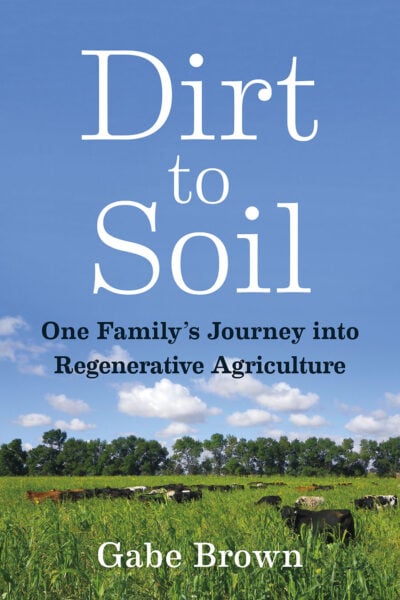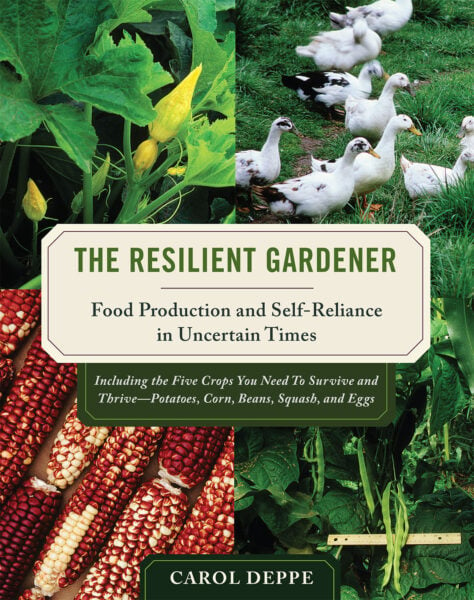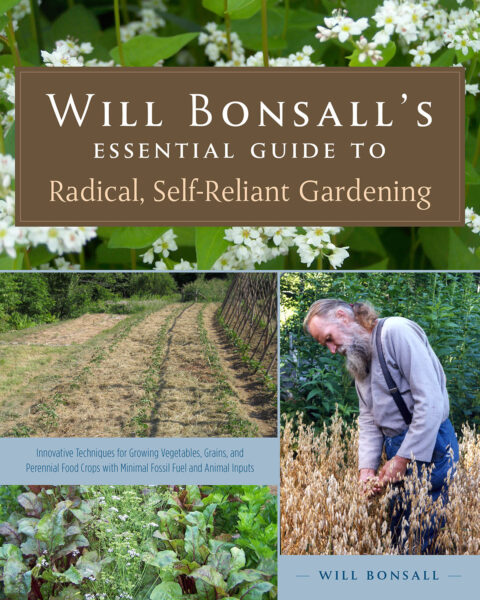How to Design Swales for Optimum Water Flow
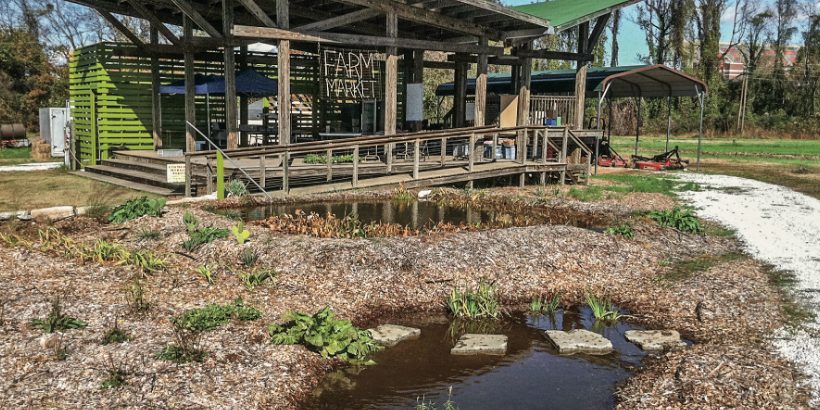
Swales are small earthen embankments used to irrigate trees, plants, and pastures. They also capture runoff to help protect soil and plants from excessive rainfall that might otherwise cause flooding and erosion. In the below Q&A, author and permaculture designer, Shawn Jadrnicek, answers questions about assessing your land, building swales near your home, and logistics involved with using a pond/swale water delivery system.
In his groundbreaking book, The Bio-Integrated Farm, Jadrnicek provides in-depth information on water flow management along with projects that use the free forces of nature—gravity, wind, sunlight, decomposition, water, and convection—to create sustainable food production systems.
(All photographs courtesy of Shawn Jadrnicek unless otherwise noted.)
Michael from Minnesota writes:
What do I need to know about making swales and other earthworks so I don’t damage the land?
Shawn Jadrnicek: There are many types of earthworks designed to harvest, move, and store water. I would first start with a plan or design for the site based on the rainfall for your area, size of the watershed flowing into the earthwork, soil type, and runoff factors like paved and roof surfaces. With sandy soils and low rainfall areas, the catchments are small in relation to the size of the watershed flowing into them and catchments are spaced further apart. With clay soils and high rainfall, the catchment area is similar in size to the watershed flowing into the catchment.
Once you know the size of the earthwork, I would next consider the equipment used to make and maintain the earthwork. Earthworks may need mowing, weeding, and planting that could be done with a simple shovel and scythe or a tractor of any size. If they collect soil and detritus the material will need to be cleaned out on occasion to maintain the water holding depth of the earthwork.
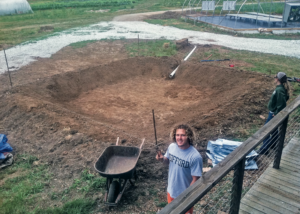
The berm for this turkey nest pond still in construction contains 11 cubic yards of soil. The drainpipe will allow us to drain the pond water into the basin on the far side.
I recommend a width of the base at least the width of the equipment used to maintain the earthwork and shallow slope angles of 3:1 for easy movement in and around the earthwork. For example, if the mower on my walk behind tractor is 34” then the base of the swale should be at least 34” and a one-foot high berm would need to be 6 feet wide to have a 3:1 slope.
Once you know the size and location of the earthworks, mark the dimensions of the downhill berm or bund of soil used to stop water in the landscape. Grading stakes placed at the center of the berm mark the exact height and slope or contour desired for the earthwork. For example, diversion channels are designed to move water and slope at a shallow 0.25% or 3 inch drop every 100 feet. Swales, contour bunds and rain gardens are designed to stop and infiltrate water and are not sloped at all, but lie on contour. Once the grading stakes are placed at the center of the berm the height of the berm is marked on the grading stake accounting for 10% shrinkage. A height of one foot is usually sufficient for runoff areas 500 square feet and less.
It’s always good to plan for the earthworks overflow with a low area that will evenly spread a thin layer of water over the soil and into a vegetated area of low slope. Of course ponds need careful attention to overflow systems. For ponds larger than water gardens, special permits and engineering specifications may be needed.
Final considerations should include removing and stockpiling topsoil, then replacing the topsoil after earthworks are completed. Earthworks also need protection from erosion by seeding and mulching immediately after completion. To protect yourself and your property from damage, always call 811 or the local authority that finds and marks underground utilities before digging.
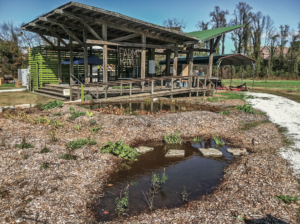
The retention basin in the foreground accepts overflow from the larger turkey nest pond at the Clemson University outdoor farm market. We think about sustainability for small details, too: the stepping-stones in the retention basin are made from recycled concrete!
Nikki from Missouri writes:
We are doing swale and berm with keyholes surrounding our house. Should we be worried about creating too large of a water lens around our foundation? Our house is an insulated slab, no basement. Our house sits on a slight incline, so the back of the house will catch water first. We are also catching our rain gutter water and diverting it into our swales.
Shawn Jadrnicek: The Natural Resources Conservation Service (NRCS) recommends placing infiltration basins such as rain gardens and swales (broad, shallow ditches intended to capture runoff) at least 10 feet from the foundation of the house. I’ve seen other recommendations calling for 15 feet from the house. The distance ensures that water seeping into the ground won’t cause moisture problems with your home’s foundation. Saturated soils are also more susceptible to frost heaving in cold climates where swelling of frozen soil shifts or cracks foundations. A plastic pond liner prevents seepage allowing basins and ponds to be built close to buildings.
Dan from Missouri writes:
I currently have three swales on contour on the primary slope of our farm. I’m getting ready to install a pond that is located above (in elevation) from our swales and I will use the pond to hydrate the swales during the dry season. My question is whether I should use buried pipe or maybe a 6-8 inch wide trench. Our top soil is pretty shallow (about 8 inches) and it’s pretty much solid clay below that. I’m trying to save the costs of not having to use pipe, but would a trench in clay really work? I know I’ll lose some water to evaporation, but is a trench as I’ve described worth the effort or am I really better off burying a pipe?
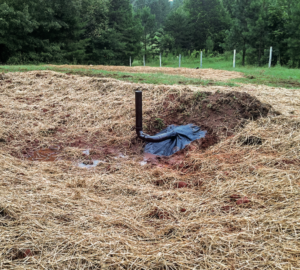
A black pipe boot surrounds the drainpipe of this newly constructed, unfilled pond. The remainder of the pond liner is covered with soil, which has been topped with straw to prevent erosion. The upright portion of the pipe is an adjustable riser that can be positioned either higher or lower than the level of the pond’s secondary overflow.
Shawn Jadrnicek: When a large volume of water runs downhill over the soil through a ditch or over land, the concentrated flow may cause erosion. In general, if I’m moving water through a ditch or channel, I like the ditch to ideally have a shallow slope of around 0.25% or a 3 inch drop every 100 feet and no more than 0.5% slope or a 6 inch drop every 100 feet. The shallow slope prevents water from moving fast and causing erosion.
With a small 12 inch wide irrigation ditch I’ve found a slope of 0.5% works better as it will prevent the ditch from overflowing when I flood it for irrigation. However, with a steeper 0.5% slope, if the ditch is long you will need to protect it from accumulating and moving water during large rain events by placing a flag dam or some other mechanism to stop the flow of water during rainfall. Using pipes would help protect the soil from erosion when moving concentrated flows down steep sloped areas.
Another consideration with ditches is mowing around them. If your planning on mowing, the ditch will complicate the effort. To make mowing easier use a device like a sickle bar mower that can extend out from the mower and mow the ditch without the mower tires entering the ditch. If the ditch has a base the width of the mower and shallow slope angles throughout, the ditch will be easy to maintain with normal mowing equipment.
Alternatively, you could flood the upper swales with a pipe from the pond and have an area of the swale designed to safely overflow the water from upper swales into lower swales overland without a ditch. This could be done by providing a level sill for overflow. The level sill would be a lower edge of the swale that is perfectly on contour allowing the water to flow in a thin sheet over a large area. The sheet flow as opposed to a concentrated flow through a small area is less likely to cause erosion. The length of the level sill will depend on the volume of water, but I would recommend at least 5 feet wide for the volume of water moving through a 4 inch pipe draining a pond. The level sill may need some protection with a layer of concrete to maintain the structure.
To get a visual overview of how swales work, check out the below video from Ben Falk, author of The Resilient Farm and Homestead.
Recommended Reads
Recent Articles
Garlic mustard: while known as “invasive,” this plant can be consumed in its entirety and has great nutritional value. Plus, the garlic-flavor is a perfect addition to any recipe that calls for mustard! The following are excerpts from Beyond the War on Invasive Species by Tao Orion and The Wild Wisdom of Weeds by Katrina…
Read MoreEveryone loves a refreshing, fermented, nutritious drink…even your garden! Take your fermentation skills out of the kitchen and into the garden by brewing fermented plant juice. The following is an excerpt from The Regenerative Grower’s Guide to Garden Amendments by Nigel Palmer. It has been adapted for the web. How to Make Fermented Plant Juice Fermented…
Read MoreWant to see your crops thrive this upcoming growing season? The key is in soil fertility and health. Spend time maintaining your soil’s health to guarantee bigger and better crops come harvest time! The following is an excerpt from No-Till Intensive Vegetable Culture by Bryan O’Hara. It has been adapted for the web. What Is Soil Fertility?…
Read MoreMany know the effects of catnip on our feline friends, but few realize that catnip has medicinal effects for humans. From stomach aches to reducing fevers, catnip is a versatile herb with many benefits. The next time you grow this plant for your cat you may end up taking a few cuttings for yourself! The…
Read MoreIt’s time to take control of your seeds and become a plant breeder! Saving your seed allows you to grow and best traditional & regional varieties, and develop more of your own. The following excerpt is from Breed Your Own Vegetable Varieties by Carol Deppe. It has been adapted for the web. Becoming A Plant…
Read More


